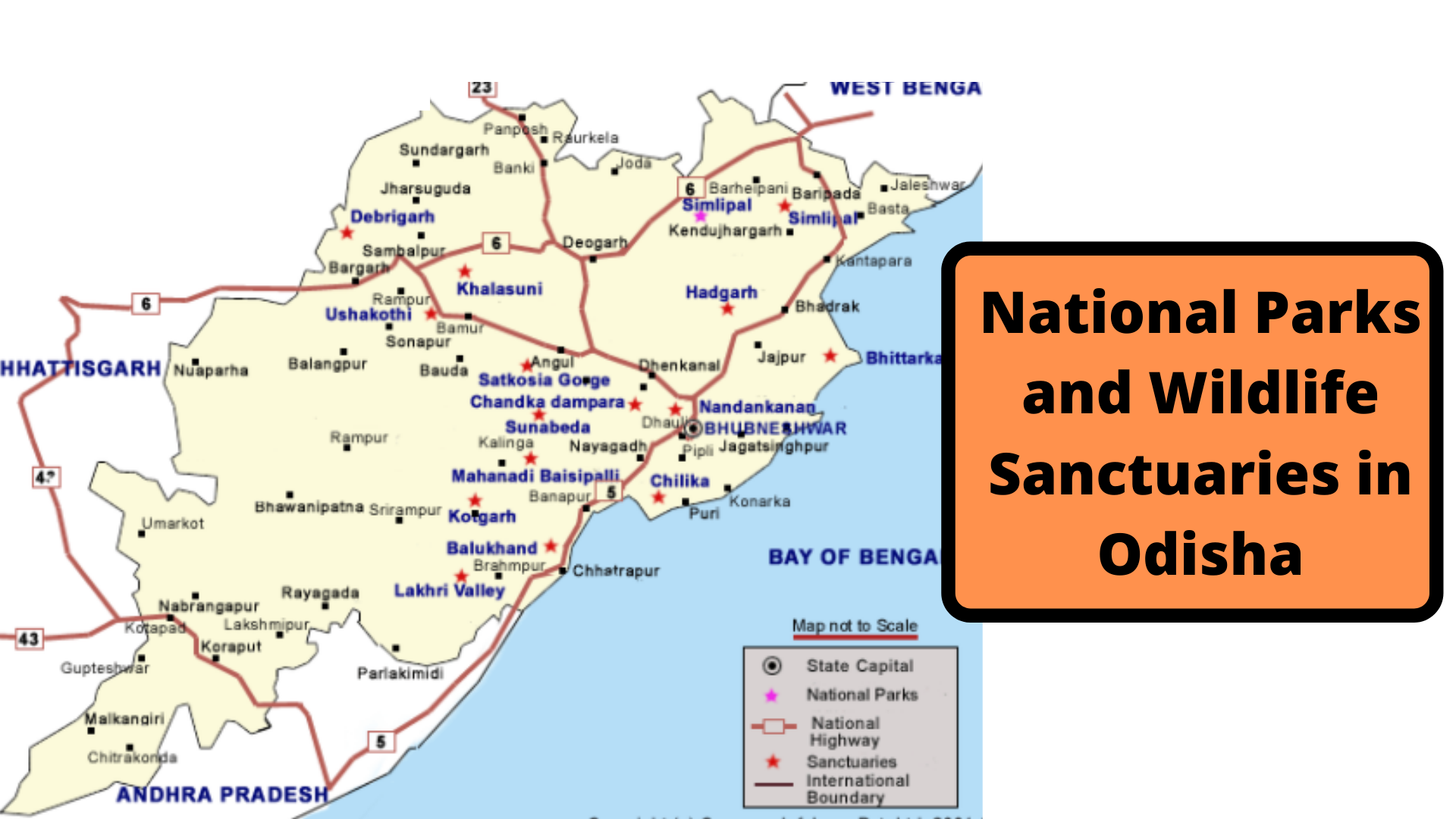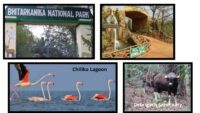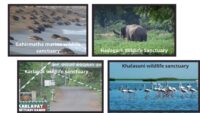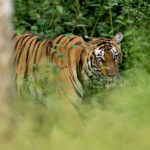Complete List of National Parks & Wildlife Sanctuaries of Odisha

Complete List of National Parks & Wildlife Sanctuaries of Odisha
Odisha is one of the states that has preserved the rich culture and tradition of India. The state is home to hundreds of ancient heritage sites Their tourism board have the tagline ‘India’s best kept secret’. The capital city. Bhubaneshwar alone has over hundreds of ancient heritage sites. Besides, there are Majestic mountains, serene beaches, spectacular wildlife, unique arts a crafts. Not to forget the breathtaking waterfalls, interesting culture, and some gorgeous landscapes.
National parks and Wildlife sanctuaries in Odisha
Over 480 kilometers of coastline on eastern side, and the Eastern Ghats on the other side. Together with the meandering rivers crisscrossing the state, creates a blend of landscape. Further the landscape varies from pine forests to wetland, to waterfalls, lakes and mangroves that shelters a wide range of flora & fauna.
Below is the complete list of all wildlife sanctuaries & national parks including bird sanctuaries, forest reserves of Odisha, India
- Bhitarkanika National Park
- Simlipal National Park
- Badrama Wildlife Sanctuary
- Baisipalli Wildlife Sanctuary
- Balukhand Konark Wildlife Sanctuary
- Chandaka Dampara Wildlife Sanctuary
- Chilika (Nalaban) Wildlife Sanctuary
- Debrigarh Wildlife Sanctuary
- Gahirmatha (Marine) Wildlife Sanctuary
- Hadgarh Wildlife Sanctuary
- Karlapat Wildlife Sanctuary
- Khalasuni Wildlife Sanctuary
- Kotagarh Wildlife Sanctuary
- Kuldiha Wildlife Sanctuary
- Lakhari Valley Wildlife Sanctuary
- Nandankanan Wildlife Sanctuary
- Satkosia Gorge Wildlife Sanctuary
- Sunabeda Wildlife Sanctuary
Bhitarkanika National Park:
Popularly known as Amazon of India, Bhitarkanika National Park has the second largest mangrove forest in India. It is a 145 square kilometers large national park in northeast Kendrapara district in Odisha.
Bhitarkanika is one such location with rich, lush green vibrant eco-system lying in the estuarine region of Brahmani- Baitarani. It is home to over 215 species of birds including winter migrants from central-Asia and Europe. Giant saltwater crocodiles and a variety of other wildlife rule the ecosystem. This makes it one of Asia’s most spectacular wildlife sanctuaries.
Chilika Lagoon:
Chilika Lake is a water lagoon with high salinity. The lake is spread across Puri, Khurda and Ganjam districts of Odisha. It is the largest coastal lagoon in India, largest brackish water lagoon in the world. The lagoon covers over 1,100 square kilometers area. It has the largest wintering ground for migratory birds that fly on the sub-continent. The lake is home to several threatened species of plants and animals.
The lagoon is home to over 160 species of birds in the peak migratory season. Microalgae, marine weeds, grasses, fish, and crab also flourish in the brackish water of the Chilika Lagoon.
Similipal National Park:
Similipal National Park is a tiger reserve in the Mayurbhanj district of Odisha. The forest reserve covers over 2,750 square kilometers. The National Park derives its name from the abundance of red silk cotton trees growing around the area. Beautiful waterfalls like Joranda and Barehipani Falls are popular here.
Amid the dense forests, you can find tall Sal trees in large numbers. Different species of fish are found in most of the rivers. The chirping of the birds is soothing here. The park is home to Bengal tiger, elephant, chausingha and gaur.
Debrigarh Sanctuary:
Located in the Bargarh district in the Indian state of Odisha, Debrigarh Sanctuary covers a total area of 346.91 square kilometers. Debrigarh Wildlife Sanctuary is declared as Eco-sensitive Zone from both ecological and environmental point of view and to prohibit class of industries occupying the woods.
There are over 40 species of mammals, 200 species of birds, 40 species of reptiles, 12 species of amphibians, 42 species of fishes, 39 species of odonates, 85 species of butterflies and 38 species of spiders found living in the sanctuary.

Satkosia Tiger Reserve:
Covering an area of about 988.30 square kilometers, Satkosia Tiger Reserve is in Angul district of Odisha. River Mahanadi, the longest River of Odisha bifurcates the Tiger Reserve and forms 22 km long canyon and is named as Satkosia Gorge. The forest has around 523.61sq km as core area.
The forest is covered with mixed deciduous forests including Sal, and riverine forest. Wildlife here includes the leopard, Indian wild dog or the (dhole), wild boars, striped hyena, sloth bear, leopard cat and the jungle cat. There are many Asian elephants in the reserve. Besides, there are crocodiles and gharials in the canyon area.
Rushikulya Rookery
Established in 1962 over a forest area of about 304.03 square kilometres, Badrama wildlife sanctuary is 22 kilometers from Sambalpur. It is also known as Ushakothi Sanctuary. The forest is covered with dry deciduous forests. Floral species like Sal, sandalwood, arjun, neem, acacia, casuarinas are frequent here. Mammals seen here are tigers, elephants, sambar leopards and bison. Around 15 tigers and 35 elephants are present in the sanctuary.
Balukhand Konark Wildlife Sanctuary
Balukhand Konark Wildlife Sanctuary is located between Puri and Konark. The place includes sandy beaches, coastal dunes, groves of introduced Casuarina trees planted in 1916–17 along with cashew plantations.
The sanctuary secures a herd of blackbuck and spotted deer. Other species found in the sanctuary include monkey, squirrel, jungle cat, jackal, mongoose, hyena, and variety of birds and reptiles. Olive ridley sea turtles are seen nesting on the beaches.
Chandaka Dampara Wildlife Sanctuary:
Chandaka Dampara Wildlife Sanctuary is in the south of Cuttack district. The sanctuary spreads over an area of 193.39 square kilometers on the up land of North-Eastern Ghat. The place is more popularly known as Chandaka Elephant Sanctuary.
The 194 square kilometers covers six types of vegetation. Secondary moist miscellaneous semi-evergreen forests, Kangada forests, coastal Sal forests, thorny bamboo brakes, planted teak and Eupatorium scrub.
Apart from elephants, leopards are more sighted here. Chital, deer, wild boar, common langur, rhesus monkey, small Indian civet, mongoose, mongoose, pangolin, sloth bear, ratel, Indian wolf and hyena commonly seen in the woods.

Gahirmatha Marine Wildlife Sanctuary:
The only marine sanctuary of Odisha, Gahirmatha Marine Wildlife Sanctuary is popularly known for having the world’s largest nesting beach for Olive Ridley Turtles. The turtles travel all the way from South Pacific Ocean to breed on the coast of Gahirmatha.
Hadgarh Wildlife Sanctuary:
Hadgarh Wildlife Sanctuary is in Keonjhar district in Odisha. Covering an area of 191 square kilometers, the wildlife sanctuary was established in 1978. Hadgarh sanctuary is linked along with Similipal tiger reserve and Kuladiha wildlife sanctuary,
A wide range of fauna can be found here. Leopard, tiger, fishing cat, jungle cat, langur, pangolin, and hyena to name a few.
Karlapat Wildlife Sanctuary:
Located in Kalahandi district, Karlapat Wildlife Sanctuary is a popular tourist attraction of Odisha. The sanctuary covers an area of 175 square kilometers and was established in 1992.
Fauna that can be seen here are tiger, leopard, sambar, nilgai, barking deer, mouse deer, a wide variety of birds like green munia, great eared-nightjar and various reptiles.
Khalasuni Wildlife Sanctuary:
Khalasuni wildlife sanctuary is spread around 160 square kilometers is one of the attractive places in Odisha. The sanctuary is covered with panoramic greenery and serene landscape, cascading waterfalls, and variety of flora and fauna.
The Khalsuni-Satkosia corridor is considered an important elephant corridor in the state. The Sanctuary is a part of Sambalpur Elephant Reserve. Khalasuni wildlife sanctuary has forests domnated by Sal trees along with its associates and miscellaneous species.

Kotagarh Wildlife Sanctuary:
Kotagarh Wildlife Sanctuary is in Kandhamal district of Odisha. The forest spreads across 399.5 square kilometer area.
The dense lush green forests with sylvan and serene landscape view are a major attraction. The major wildlife seen here include elephant, gaur, sambar, spotted deer, peafowl, red jungle fowl and a variety of reptiles.
Kuldiha Wildlife Sanctuary:
Situated in the Balasore district of Odisha, India, Kuldiha Wildlife Sanctuary is spread across 272.75 square kilometers. Elephants are popularly known here. Hence, a watch tower was built at Garsimulia for animal lovers to have a look at elephants. They are usually seen bathing or drinking water from a small stream that runs right through the reserve.
Sal tree dominates here among mixed deciduous forests. Various animals inhabit the forest, including tiger, leopard, elephant, gaur, sambar, giant squirrel, hill myna, peafowl, hornbills, other migratory birds, and reptiles.
Lakhari Valley wildlife sanctuary:
Lakhari Valley wildlife sanctuary has an area 118 square kilometers. The sanctuary is in the Eastern Highlands moist deciduous forests region. The sanctuary was established in 1985 and is a dwelling place of many elephants.
Sunabeda Wildlife Sanctuary:
A wildlife sanctuary and a proposed tiger reserve, Sunabeda Wildlife Sanctuary is in the Nuapada district of Odisha. The sanctuary covers a total area of 600 square kilometers.
Tiger, leopard, Indian gaur, sloth bear, barking deer, wild boar and blue bull conquer the woods.

Do’s and don’ts while on safari:
Do’s
- Groom up right for the adventure
Wear light colored dress. Make sure that the cloth you wear covers the limbs. Avoid bright colors. Multi colored dress is recommended while on safari.
2. Less luggage more comfort
This is usual and better understood by the regular travelers. Carry as less luggage as possible, which holds good for any of the expeditions. Safari expeditions can be tiresome and exhausting and carrying only what is required helps ease your tension.
3. Stay calm
Making unnecessary noises would only end up inviting trouble. Stay excited but being calm and composed throughout the exploration.
4. Do not miss your camera.
Smile! You are on a camera throughout the venture. You will come across wildlife sightings that are unexpected, breathtaking, and once in a lifetime moment. Capture them with a smile.
Carry your sunglasses, hats, and sunscreen to keep yourself safe from sun rays and sunburns. Wear strong jungle shoes along with socks. Avoid footwears which expose your feet to wild nature.
5. Always have an expert guide
The naturalists are the crew who had been in and around the jungle for years. You need a high chance of sighting wildlife; it is always recommended to have them for your venture.
Don’ts:
- No littering
Ground rule – Do not carry non biodegradable materials. The forest officials in any forests are strict of this and you may end up paying hefty funds just to ruin your holiday. Cleanliness is the key.
2. No feeding to animals
This is like digging your own grave. The behavior of wild animals are predictable to no one and hence feeding them would be risky.
3. Cell Phones switched off throughout the drive
You are on a vacation and no official/unofficial calls should spoil your vacation. Long press the power button of your device and keep it aside.
4. No loud conversations
The excitement level will be at peak especially at the time of sighting. Just enjoy the moment with less or no talks.
5. No smoking or liquors
Wildlife safari is a way to connect with nature and any toxication is not at all entertained.
6. Do not over rely on properties for safari vacations.
There are a lot of licensed properties who can arrange for safari drives when you book with them. However, they do not promise. Pro-tip. Confirm your safari drives before booking the properties.
6 Benefits of booking your holiday with WildTrails
- Hassle free booking experience.
- Airport/ railway station, bus stand pick-up and drops shall be arranged.
- 24X7 support assistance from the experts.
- Expert Tiger Tracker for your safari.
- Sighting data (Exclusively from Wildtrails) for effective planning of your wildlife venture.
- We take care of your complete holiday, from transfer, accommodation, safari, meals to make it stress-free.

WildTrails of India – “One Stop Destination for all Indian Wildlife Enthusiasts“
PS: Please be a responsible wildlife tourist; No littering, No sounds, No feeding, no getting down from the safari jeep (when on safari), No phon
With 4 years of Sightings data + Extensive expert tracker network in jungles, our customers had the best wildlife experiences.
Buy Wildlife Fashion Accessories
Exclusive Online Store for wildlife products
Packages
Packages Loading...
Recent Posts








